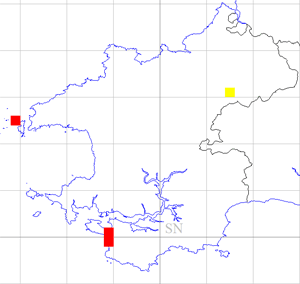Lapwing - 2003-07
 Monday, May 7, 2012 at 4:58PM
Monday, May 7, 2012 at 4:58PM In winter they can appear in flocks of several hundred to a few thousand and occur widely across farmland and coastal habitats. The number of pairs attempting to breed in Pembrokeshire has continued to decline over the last 20 years, continuing a trend noted in Donovan and Rees (1994).
Lapwing distribution, as indicated by the number of tetrads in which they were found, fell by a massive 86%, between 1984-88 and 2003-07, reflecting the significance of the overall decline in the breeding population. All atlas categories declined by large amounts. Breeding numbers are also declining in many other parts of Britain, and they are red-listed in the Birds of Conservation Concern 3 (Eaton et al., 2009).
The BBS index indicated a UK-wide decline of 18% between 1994 and 2007, but there were insufficient 1km squares sampled to give a Wales index for the species.
It was estimated that there were around 70 pairs in Pembrokeshire during 1984-88. During 2003 – 2007 the maximum recorded breeding population in any one year was only 14 pairs, in 2003, with between about nine and 12 breeding pairs recorded each year subsequently, a decline of between 80 and 87%.
One or two pairs have attempted to breed on the Castlemartin peninsula, but recently the entire population has been more or less split between two key breeding centres at Ramsey Island and the old dismantled BP oil tank farm at Kilpaison. Ringing of nestlings by the Pembrokeshire Ringing Group at the latter site is showing that some young are surviving and returning in later years, possibly to breed in the same area.
Management of their breeding habitat is being carried out by the RSPB on Ramsey; this includes minimising potential disturbance from visitors to the island. Recent attempts by the RSPB to help create suitable arable conditions in the Castlemartin Corse/Broomhill Burrows area have, so far, failed to attract the birds to stay and breed successfully here.
Bob Haycock

Fieldwork 2003-07 (based on 490 tetrads)
Red = breeding confirmed = 3
Orange = breeding probable = 0
Yellow = breeding possible = 1
Total tetrads in which registered = 4 (0.8%)
 PBBA 2003-7,
PBBA 2003-7,  RJH in
RJH in  Lapwing
Lapwing 

Reader Comments